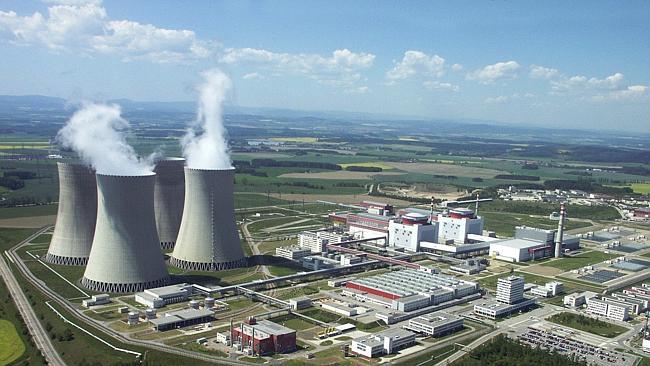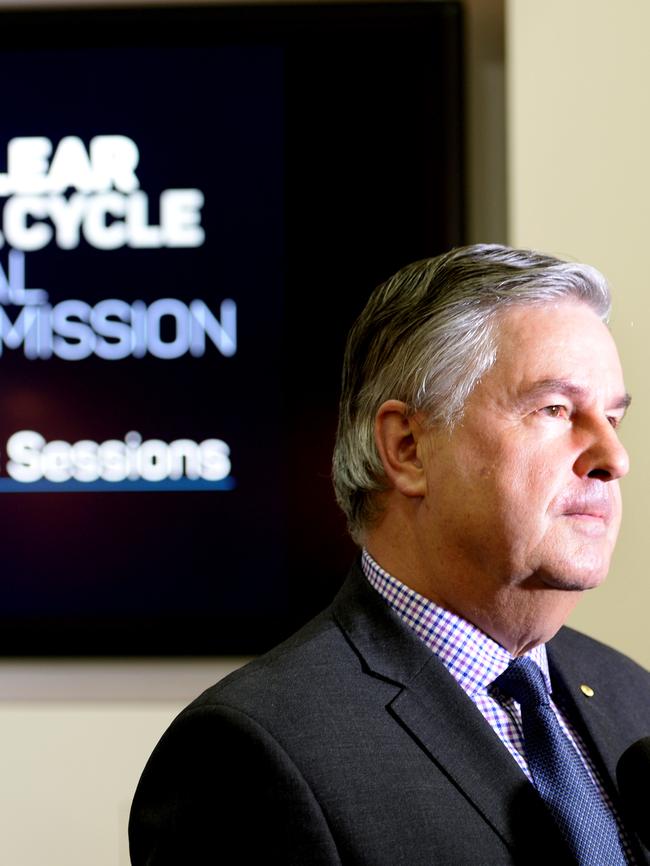Nuclear Fuel Cycle Royal Commission tentative findings report to be released
FOR months now, a Royal Commission has been examining the idea a nuclear industry in SA — and now the initial report is due out today. Here’s what it’s likely to say — and the possible impact on SA.

SA News
Don't miss out on the headlines from SA News. Followed categories will be added to My News.
- Dramatic switch in SA’s public opinion towards nuclear
- Get set for a nuclear future, SA
- Nuclear reactor hard, expensive, but would create green power
- Renewable energy, not nuclear, way forward
- The $20bn blueprint to create an SA nuclear industry
SOUTH Australia is likely to embrace a nuclear industry in today’s release of a landmark Royal Commission report, drawn up by respected former state governor Kevin Scarce. Chief Reporter PAUL STARICK analyses the polarising topic.
What is happening on Monday?
The Nuclear Fuel Cycle Royal Commission, ordered in March last year by Premier Jay Weatherill, will release its tentative findings. Royal Commissioner Kevin Scarce will publicly release the report at 11am.
What will the report say?
It is likely to recommend a nuclear power reactor to spearhead a push to lure industries to South Australia with low-cost clean energy. It also is likely to recommend a high-level nuclear waste repository for the state but not pinpoint a possible site. Further expansion of the state’s existing uranium mining and exploration is also highly likely to be backed. Nuclear enrichment, in which uranium is turned into a nuclear fuel, has received less public attention from Rear Admiral Scarce. But enrichment might be backed as part of a move to add value to the state’s significant uranium resources. The Olympic Dam mine, 575km north of Adelaide, is the world’s largest uranium deposit.
Why should we get more involved in the nuclear industry?
Expanding SA’s role in nuclear energy generation, waste storage, mining and enrichment would enable the state to capitalise economically on this world-leading resource. There is significant appeal in forging a lucrative new industry when unemployment is the nation’s highest, hovering between 7 and 8 per cent. There also is a moral argument that if SA is happy to export uranium from the world’s biggest resource, it should take responsibility for dealing with the waste produced, particularly from nuclear power plants.
What about the environment?

Fierce opposition is expected from national and state environment groups, which have banded together from the Royal Commission’s start to question its credibility, process and “uncritical” promotion of pro-nuclear claims. Conservation SA, the Australian Conservation Foundation and Friends of the Earth Australia in December released a report accusing the Royal Commission of conflicts of interest and an unwillingness to correct factual errors. They argue the Royal Commission was not a response to a pressing public issue but a calculated political initiative with a pro-nuclear agenda.
What about low-cost clean energy?
Some renowned environmentalists and scientists have advocated nuclear power as the only sensible and economic option to avert catastrophic global warming. Among them are Greenpeace co-founder Patrick Moore and Professor James Lovelock, the originator of the Gai Theory, which considers Earth as a self-regulated living being. Professor Lovelock was a keynote speaker at the 2007 Adelaide Festival of Ideas, backed by then-premier Mike Rann’s Sustainability and Climate Change division.
Is this economical for SA?
Until Premier Jay Weatherill broke ranks by calling the Royal Commission, Labor had repeatedly branded nuclear energy uneconomic for Australia. Most recently, this was repeated by federal Opposition Leader Bill Shorten, who said he neither supported nuclear energy nor saw it as a viable prospect.
Rear Admiral Scarce — while careful not to take any formal position before his report’s release — in December last year emphasised the “certain amount of attraction” of small modular nuclear reactors to provide a plentiful supply of greenhouse gas emissions-free power. The Royal Commission heard We can build power plant for $17bn.
A business case ordered by the Royal Commission, to be detailed today, assumes nuclear power plant operations would start in 2030 and canvasses electricity demand in 2020, 2030 and 2040.
The state Economic Development Board also has informed the Royal Commission in a bid to supply credible numbers about business opportunities created by low-cost clean energy.
What about nuclear waste?
Before an overseas fact-finding mission last year, Rear Admiral Scarce highlighted Finland’s “world-class” underground storage of spent nuclear fuel. This is being built at the Olkiluoto Nuclear Power Plant, on the country’s west coast. It involves putting spent nuclear fuel up to 520m underground in boron steel canisters enclosed in copper cases.
South Australia’s stable geology and political environment have been identified in previous studies as a prime site for storing nuclear waste.
A company called Pangea Resources — a joint venture of British Nuclear Fuels, Golder Associates and Swiss radioactive waste management entity Nagra — proposed such a facility in 1998.
South Australia responded with the Nuclear Waste Storage Facility (Prohibition) Act of 2000.
How is this different to the nuclear waste dump being proposed by the Federal Government?
Three of six sites earmarked for a permanent national radioactive waste dump are in SA — two near Kimba and one north of Port Augusta. This dump would store or dispose of low-level waste from more than 100 sites across the country, including schools and universities. This might include laboratory items such as paper, plastic and glassware. It will not house high-level waste.
What about the public reaction?
Overwhelming support for expanding the nuclear industry was revealed in a Sunday Mail survey of more than 5700 people, published last November. Nuclear-related industry was among the top three rated by respondents as being the most important for the SA economy in the next 20 years. The Your Say, SA survey showed 47 per cent support for a nuclear power plant and 43 per cent backing a national nuclear waste dump.
This represented a dramatic switch from 2004, when public outrage forced the federal government to abandon plans for a national nuclear waste dump near Woomera.
What happens next?
A week-long public information program, involving a series of public meetings across the state. The first is tonight at the Adelaide Town Hall from 6pm. The Commission also will visit key regional cities and towns, including Port Pirie, Port Augusta, Whyalla, Port Lincoln, Mt Gambier, Ceduna, Renmark, Oak Valley and Umuwa.
Will the public consultation matter?
Rear Admiral Scarce has repeatedly stressed the importance of community debate and education if any proposals are to succeed. He also has said he will listen to the consultation and, if necessary, make changes in the final report to be released on May 6.
What about the State Government?
The Government will respond after it is handed the final report. If it adopts all, or any, of the recommendations, changes will be long-term because of the time taken to ramp up a nuclear industry.
This would require legislative changes at a state and federal level and, as the Royal Commission report will emphasise, public support and consent is critical.
Will the report be highly technical?
Four separate sections will detail findings on each of the Commission’s terms of reference.
The report is likely to contain a brief plain-English summary of recommendations for each term of reference, underpinned by supporting statements with extensive detail.
How can I get a copy?
Download a copy from 11am on Monday from www.nuclearrc.sa.gov.au or contact the Royal Commission on (08) 8207 1480 or at Level 5, 50 Grenfell St, Adelaide SA 5000.
What’s been happening?
The Nuclear Fuel Cycle Royal Commission was commissioned by Premier Jay Weatherill in March last year.
The terms of reference are to examine the potential for South Australia’s further participation in the nuclear fuel cycle.
The Royal Commission considered:
FURTHER exploration and extraction of uranium
ENRICHMENT of uranium
NUCLEAR power generation.
STORAGE and disposal of nuclear waste.
This has involved investigating the feasibility and viability as well as the risks and opportunities associated with these activities.
More than 250 submissions were provided to the Royal Commission, which heard from 128 witnesses over 34 sitting days.



